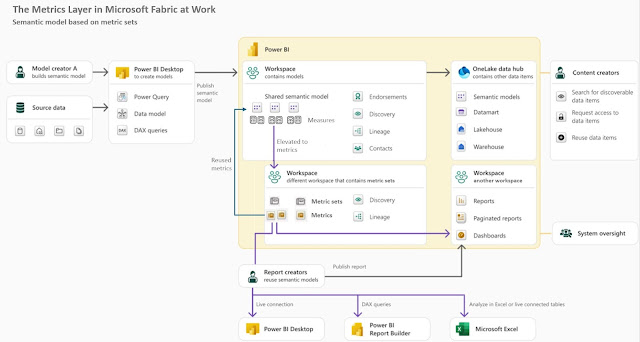Disclaimer: This is work in progress intended to consolidate information from various sources for learning purposes. For the latest information please consult the documentation (see the links below)!
Last updated: 07-May-2024
 |
| The Metrics Layer in Microsoft Fabric (adapted diagram) |
[new feature] Metrics Layer (Metrics Store)
- {definition}an abstraction layer available between the data store(s) and end users which allows organizations to create standardized business metrics, that are rooted in measures and are discoverable and intended for reuse
- ⇐ {important} feature still in private preview
- {goal} extend existing infrastructure
- {benefit} leverages and extends existing features
- {goal} provide consistent definitions and descriptions [1]
- consistent definitions that include besides business logic additional dimensions and filters [1]
- ⇒ {benefit} allows to standardize the metrics across the organization
- ⇒ {benefit} enforce to enforce a SSoT
- {goal} easy management
- via management views
- [feature] lineage
- [feature] source control
- [feature] duplicate identification
- [feature] push updates to downstream uses of the metrics
- {goal}searchable and discoverable metrics
- {feature} integration
- based on Sempy fabric package
- ⇐ a dataframe for storage and propagation of Power BI metadata which is part of the python-based semantic Link in Fabric
- {goal}trust
- [feature] trust indicators
- {benefit} facilitates report's adoption
- {feature} metric set
- {definition} a Fabric item that groups together a set of metrics into a mini-model
- {benefit} allows to reduce the overall complexity of semantic models, while being easy to evolve and consume
- associated with a single domain
- ⇒ supports the data mesh architecture
- shareable
- can be shared with other users
- {action} create metric set
- creates the actual artifact, to which metrics can be added
- {feature} metric
- {definition} a way to elevate the measures from the various semantic models existing in the organization
- tied to the original semantic model
- ⇒ {benefit} allows to see how a metric is used across the solutions
- reusable
- can be reused in other fabric artifacts
- new reports on the Power BI service
- notebooks
- by copying the code
- can be reused in Power BI
- via OneLake data hub menu element
- can be chained
- changes are propagated downstream
- materializable
- its output can be persisted to OneLake by saving it a delta table into a lakehouse
- {misuse} data is persisted unnecessarily
- {action} elevate metric
- copies measure's definition and description
- ⇒ implies restructuring, refactoring, moving, and testing a lot of code in the process
- {misuse} data professionals build everything as metrics
- {action} update metric
- {action} add filters to metric
- {action} add dimensions to metric
- {action} materialize metric
References:
[1] Power BI Tips (2024) Explicit Measures Ep. 236: Metrics Hub, Hot New Feature with Carly Newsome (link)
[2] Power BI Tips (2024) Introducing Fabric Metrics Layer / Power Metrics Hub [with Carly Newsome] (link)
Resources:
[R1] Microsoft Learn (2025) Fabric: What's new in Microsoft Fabric? [link]
Acronyms:
SSoT - single source of truth ()
SSoT - single source of truth ()
